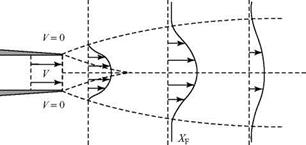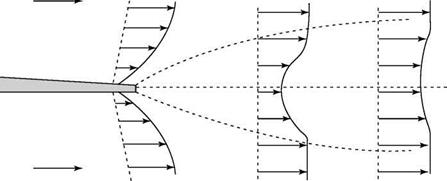Wakes
As in the discussion of the drag of an airfoil in Chapter 3, a wake forms behind a body because of the boundary layer leaving the body (as illustrated) or because of separation on the surface of the body (wake flow downstream of a cylinder). Behind the body trailing edge shown in Fig. 8.27, the two boundary layers merge. Then, the wake width increases with increasing downstream distance and the mean velocity in the wake decreases.
Free Jet
A free jet (here, a free-slot jet) is one that exhausts into a fluid at rest. Initially, the free jet at the exit has a uniform “core” with a free shear layer on either side. As the jet length increases, viscous-shear effects at the sides retard the flow at the center of
|
Figure 8.27. Wake behind a flat plate. |
 |
the jet and the jet has a rounded profile (e. g., station XF). When the constant-velocity jet core disappears, the jet is said to be fully developed. With increasing distance downstream, the jet spreads and the maximum velocity decreases; both effects are caused by friction. Ultimately, the jet is dissipated.
All of these flows are unstable and quickly tend to become turbulent shear flows. It is difficult to generate them in the laboratory as laminar flows.












